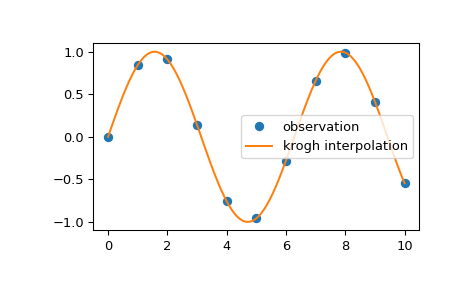scipy.interpolate.
krogh_插值#
- scipy.interpolate.krogh_interpolate(xi, yi, x, der=0, axis=0)[源代码][源代码]#
用于多项式插值的便捷函数。
更多详情请参见
KroghInterpolator。- 参数:
- xiarray_like
插值点(已知的 x 坐标)。
- 一array_like
已知的 y 坐标,形状为
(xi.size, R)。解释为长度为 R 的向量,或者当 R=1 时为标量。- xarray_like
要评估导数的点或点。
- derint 或 list 或 None, 可选
要计算的导数数量,或者为所有可能非零的导数(即等于点数的数量),或者是一个要计算的导数列表。这个数量包括函数值作为’第0阶’导数。
- 轴int, 可选
yi 数组中对应于 x 坐标值的轴。
- 返回:
- dndarray
如果插值器的值是 R-D,则返回的数组将是导数的数量乘以 N 乘以 R。如果 x 是标量,中间维度将被删除;如果 yi 是标量,则最后一个维度将被删除。
参见
KroghInterpolatorKrogh 插值器
注释
构造插值多项式是一个相对昂贵的过程。如果你想重复评估它,考虑使用 KroghInterpolator 类(这是此函数所使用的)。
示例
我们可以使用 Krogh 插值法对 2D 观测数据进行插值:
>>> import numpy as np >>> import matplotlib.pyplot as plt >>> from scipy.interpolate import krogh_interpolate >>> x_observed = np.linspace(0.0, 10.0, 11) >>> y_observed = np.sin(x_observed) >>> x = np.linspace(min(x_observed), max(x_observed), num=100) >>> y = krogh_interpolate(x_observed, y_observed, x) >>> plt.plot(x_observed, y_observed, "o", label="observation") >>> plt.plot(x, y, label="krogh interpolation") >>> plt.legend() >>> plt.show()
